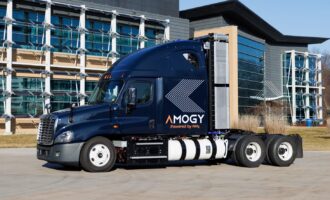Automotive industry gears up for next generation challenges
Scientific researchers and leading professionals from the automotive, oil and petrochemical industries came together on the 4th‐5th November to discuss the future of world transport and how cutting edge science can be harnessed to help deliver the huge increase in energy demand required to serve the global population, set to rise to 9 billion people by 2050.
The Illuminating Challenges in Automotive Research (iCAR) 2015 Conference was jointly hosted by Infineum UK Ltd, one of the world leaders in the formulation, manufacture and marketing of petroleum additives for fuels and lubricants, and Diamond Light Source, which offers state‐of‐the art experimental facilities that are instrumental in keeping the UK at the forefront of scientific research.
Collaboration is essential if automotive companies and academic researchers are to successfully find efficient and cost‐effective ways to develop innovative technologies to the satisfaction of customers and regulators alike. iCAR 2015 took place at Diamond Light Source, the UK’s national synchrotron science facility in Oxfordshire, and was attended by over 100 delegates including representation from Shell, BP Castrol, Ilika, Johnson Matthey, and the Warwick Manufacturing Group.
Speakers presented on a broad range of industry challenges and research areas, describing how the sector might find answers to questions such as: Which energy innovations in the automotive sector stand the best chance of commercial success? What will the future engine market look like? How can science facilities like Diamond help to deliver advanced fuels, oils, and lubricants? What improvements can be made to hardware design, fabrication, and processing? Can novel alloys be designed to improve the efficiency and durability of future vehicles? How can we further improve emission control catalysts? How can we make more efficient and longer lasting hybrid batteries?
In his Keynote address Yann Cramer, General Manager Innovation & Technology Sourcing, Shell Lubricants, described how Shell uses its well established New Lens Scenarios(Mountains and Oceans) to explore plausible alternative visions of the future. These help test and strengthen the business decisions that are made in the present. Yann comments, “Innovation needs to be about human progress. We expect that the growing global population and standards of living are going to lead to a doubling of primary energy demand between 2000 and 2050. But the technical and societal solutions for primary energy production could be radically different depending on the scenario. For example, nuclear power would stand a better chance of becoming a significant component of the energy mix in the Mountains scenario, where status quo favours the currently influencial and major infrastructure decisions are implemented from the top down. Solar power can be organised locally, so in Oceans, where decision‐making is more localised and change emerges largely from the bottom up, this form of primary energy would grow to make up a larger percentage of the energy mix. “
“In transport, technological and societal transformations will also have a critical role to play. In my view, affordability is key, alongside ecological footprint and customer convenience. A vehicle technology that brings about progress and achieves affordability soonest will stand a better chance of being widely adopted. There is plenty of room for shaking the status quo: given the current inefficiencies of the passenger transport system, improving energy efficiency is a big opportunity for the automotive sector in the short and long term.”
Today, huge advances in analytical techniques to help address automotive challenges are within reach for researchers who make use of the powerful techniques on offer at large scale science facilities such as Diamond. Here, a synchrotron produces X‐ray, infra‐red and ultraviolet beams of exceptional brightness, which allows the scientific community to undertake structural, chemical and imaging investigations of a broad range of materials on very fast timescales and under industrially relevant conditions.
These capabilities are very well suited to a wide variety of automotive research applications for both industrial and academic research. They allow scientists to investigate samples and processes at atomic and nanoscale resolutions, delivering detailed insights that are unobtainable back in home laboratories. Diamond is an expanding facility and new automotive research opportunities are in the pipeline with the addition of an electron microscopy facility in collaboration with Johnson Matthey and Oxford University.
Prof. Andrew Harrison, Diamond’s Chief Executive, adds: “Diamond has a range of experimental techniques that can help those working on complex automotive related problems at the atomic scale. Diamond is interested in the best and most challenging scientific questions to be studied here. We are delighted to have hosted iCAR 2015 and some very fruitful discussions have taken place and I am confident that successful R&D undertaken here will translate into commercial success in the future.”
Prof. Sven Schroeder, Diamond‐Infineum Bragg Chair, University of Leeds, uses Diamond’s soft X‐ray research applications to probe local electronic and geometric structure in materials. A recent project had been to investigate the behaviour of additives in lubricants down at the atomic level. Prof. Schroeder explains, “Understanding how additives help protect the engine at the most fundamental level is critical for the development of more efficient components. Diamond is critical to these investigations and the long term goal is to use the knowledge gained to improve performance, help engines last longer, and deliver improved efficiency.”
Chris Locke, Executive Vice President Marketing and Technology at Infineum, concludes: “As a sector, the automotive industry has a complex set of challenges to overcome to bring about a successful, more sustainable future. Cutting edge scientific research has a vital role to play, but it is also critical that we discuss these challenges across traditional boundaries so that the solutions that we come up with are workable in the context of society’s mobility needs as a whole. iCAR2015 has been fantastic in terms of helping people to consider different perspectives and come up with new ideas. We hope it will also spark future collaborations and developments as we plan energy and mobility developments out to 2050 and beyond.”









